Antipasto salad isn’t just a dish—it’s a vibrant experience, brimming with bold Italian flavors, rich cured meats, tangy cheeses, crisp vegetables, and marinated goodness. Whether served as a hearty appetizer or a satisfying main course, this colorful medley delivers flavor and texture in every bite. In this recipe, I’ll guide you through crafting the ultimate antipasto salad at home—perfect for picnics, gatherings, or a quick weekday lunch. You’ll discover how to balance salty, creamy, and acidic elements for maximum flavor. Plus, I’ll answer common questions about storage, preparation, and the best dressings to bring it all together.
My Italian-Inspired Twist on Classic Antipasto Salad
A Family Gathering That Started It All
When I first made antipasto salad, it was a warm July afternoon in Asheville, and our porch was buzzing with cousins and neighbors, all eager for something cool and flavorful. I remembered the spread my Grandma Mabel used to serve—platters layered with olives, salami, and artichokes. That memory sparked my twist: instead of laying everything out flat, why not toss it together like a salad, with a punchy vinaigrette to tie it all in? That day, my antipasto salad became the star of the table, vanishing faster than my lemon-thyme shortbread cookies. Ever since, it’s been a summer go-to.
Why This Antipasto Salad Works
What makes this version so good? It’s a balanced layering of bold and subtle: salty prosciutto, creamy mozzarella, vinegary peppers, and crisp romaine. The homemade dressing—a simple red wine vinaigrette with garlic and oregano—brings everything together with a tangy brightness. It’s easy to scale up for a crowd or portion for lunch. Plus, it holds up well in the fridge, making it ideal for meal prep. Unlike the basic side salads, this one feels like a full dish. Just like in my gut-healing bone broth, the key is texture and flavor harmony.
For a quick pairing, I often serve it with something tangy on the side like my fresh dill pickle salad or even a sip of pineapple cucumber salad on hot days—it’s that versatile.
Building the Best Homemade Antipasto Salad
What’s on an Antipasto Salad: The Classic Components
The beauty of antipasto salad is how it celebrates variety. At its heart, it’s an assembly of cured meats, marinated vegetables, cheeses, and greens. Most traditional antipasto salads feature sliced salami, pepperoni, mozzarella, cherry tomatoes, and olives. You’ll often find roasted red peppers, artichoke hearts, and pepperoncini adding tang and depth. In my version, I love tossing in chopped romaine or baby spinach for a fresh crunch, and occasionally some sun-dried tomatoes or grilled zucchini to echo a summer garden feel.
This dish draws from the Italian antipasto platter, where each bite offers contrast—salty meats, soft cheese, and briny olives—all tied together with olive oil or vinaigrette. And while antipasto refers to the first course of an Italian meal, turning it into a salad gives you a meal that’s quick, flavorful, and satisfying any time of day.
If you’re already a fan of vegetable-packed dishes, my easy retinol carrot salad has a similar vibrant crunch and brightness that complements any Mediterranean meal.
Antipasto vs. Antipasti Salad: What’s the Difference?
It’s easy to get confused—after all, “antipasto” and “antipasti” sound nearly identical. In Italian, “antipasto” means “before the meal” and refers to a singular dish or platter. “Antipasti” is simply the plural form, used when describing multiple items or servings. So when we say “antipasto salad,” we’re referring to a salad inspired by the components of a traditional antipasto plate.
“Antipasti salad,” while not incorrect, tends to show up more in casual usage, especially on menus. But whether you call it antipasto or antipasti salad, what matters most is flavor and freshness. Stick to the essentials, avoid overcrowding with too many ingredients, and let each component shine.
This same keep-it-simple principle is what makes my korean cucumber salad so refreshing. Minimal ingredients, maximum flavor.
Common Ingredients and Flavor Pairing in Antipasto Salad
The Must-Haves in a Flavorful Antipasto Salad
A great antipasto salad isn’t random—it’s artfully composed. You want it to taste like an Italian deli came to life in your kitchen. Start with greens like crisp romaine or peppery arugula, then layer on cured meats—salami, pepperoni, or prosciutto are all fair game. Don’t skimp on cheese: cubed provolone or creamy mozzarella pearls offer balance. Next, introduce the marinated powerhouses: kalamata olives, roasted red peppers, artichoke hearts, and pepperoncini. These not only provide brine and tang, but they keep the salad from feeling flat.
I like to add texture with thin-sliced red onion or even crunchy celery. A sprinkle of oregano and a splash of good olive oil bring it all together—though if you really want to elevate it, make a simple red wine vinaigrette with Dijon mustard and garlic. It’s the kind of balance you’ll also find in my pineapple cucumber salad, where bright acidity meets mellow sweetness.
5 Mistakes to Avoid in Pasta & Antipasto Salads:
You’d be surprised how often a good antipasto salad gets wrecked. Here’s how to dodge the usual traps:
- Overdressing. A heavy hand ruins texture. Always toss lightly, then adjust.
- Skipping briny elements. Without olives or pickled veg, your salad will taste one-note.
- Using bland cheese. Low-moisture mozzarella has no place here—go fresh or sharp.
- Adding ingredients while hot. Chill roasted veggies or pasta fully, or you’ll wilt your greens.
- Forgetting balance. Too much salt from meats and cheese without acid = a flat flavor profile.
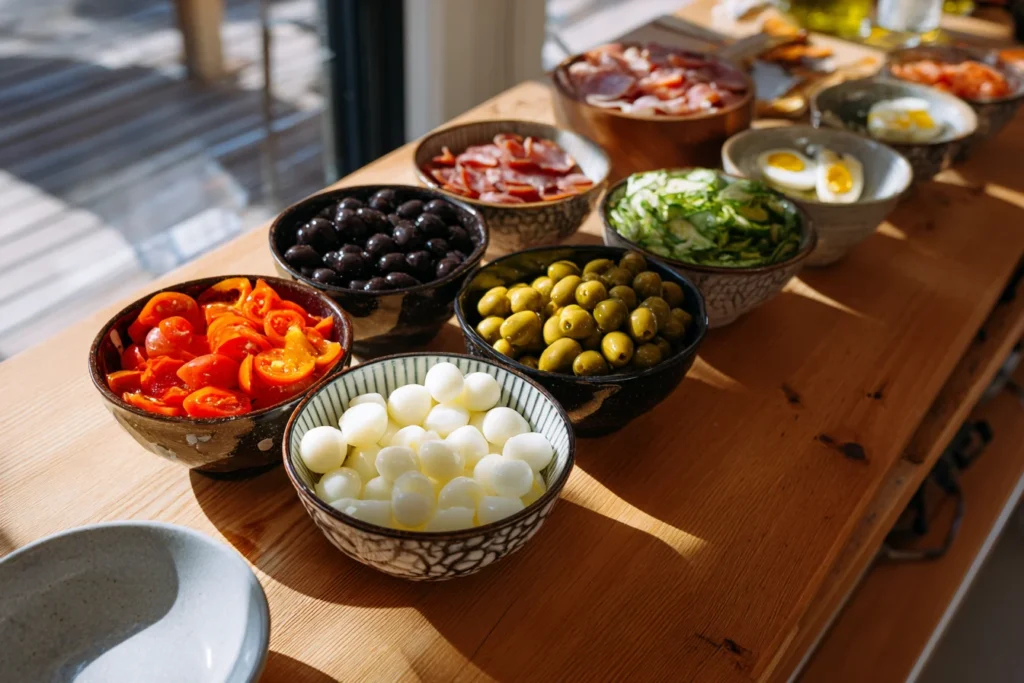
These aren’t just tips—they’re survival rules, the same kind I follow in bold-flavored dishes like my easy retinol carrot salad and korean cucumber salad. If you layer wisely and avoid overpowering additions, your antipasto salad will sing.
And if you’re feeling fancy, sip on a glass of ginger tea while prepping—it sets the tone for a calm kitchen.
Storage, Make-Ahead Tips & Best Dressings for Antipasto Salad
Can You Make Antipasto Salad the Night Before?
Yes—and in fact, it often tastes better the next day. The flavors from the marinated vegetables, meats, and dressing continue to develop overnight, creating a salad that’s more unified and robust. But here’s the trick: keep the greens and vinaigrette separate until just before serving. This preserves the crunch and avoids sogginess.
If you’re making it ahead, store your chopped ingredients layered in a large container or jar—meats and cheese at the bottom, then veggies, and greens on top. For quick lunches, I pack mine in glass jars and just shake them up with dressing right before eating. It’s a strategy I also use when prepping hydrating switchel or turmeric ginger lemonade: flavor improves with a little rest.
How Long Does Antipasto Salad Last in the Fridge?
Once dressed, antipasto salad is best eaten within 1–2 days for peak texture. Without dressing, it can last up to 4 days refrigerated in an airtight container. The cured meats and pickled veggies hold up well, but the greens and cheeses can begin to wilt or weep moisture over time.
To extend shelf life, store dressing on the side and add fresh greens just before serving. If you’re using sturdy greens like kale or radicchio, they’ll hold up longer than tender romaine or spinach. I like to prep a big batch of toppings early in the week and toss individual salads as needed. It’s the same approach I use for making chrysanthemum goji tea last multiple days—store smart, mix fresh.
FAQs
What is on an antipasto salad?
A typical antipasto salad includes cured meats like salami or prosciutto, cheeses such as mozzarella or provolone, marinated vegetables (artichoke hearts, olives, roasted red peppers), cherry tomatoes, pepperoncini, and a bed of greens. It’s dressed with olive oil or a tangy vinaigrette and often includes red onions or fresh herbs for brightness.
What is the difference between antipasto and antipasti salad?
“Antipasto” is the singular term meaning “before the meal,” referring to a single Italian appetizer plate. “Antipasti” is the plural—meaning a spread or group of appetizers. When we say “antipasto salad,” we’re referring to a single dish inspired by those ingredients, tossed and served as a salad.
What are the common ingredients in antipasto?
Core components include salami, ham, marinated mushrooms, olives, roasted peppers, mozzarella, provolone, and artichoke hearts. Each offers its own texture—meaty, crunchy, creamy, or tangy—and when combined, they build that iconic Italian flavor palette.
What are the five mistakes to avoid in pasta salad (and antipasto too)?
Overdressing, skipping briny ingredients, using bland cheese, mixing in hot components, and failing to balance salty, acidic, and creamy elements. These pitfalls lead to a flat or soggy salad.
Conclusion: Your Antipasto Salad, Your Way
Antipasto salad is more than just a starter—it’s a canvas for creativity and flavor. Whether you’re serving it at a summer gathering or prepping lunches for the week, this salad’s got everything: crunch, creaminess, salt, acid, and heart. By keeping ingredients balanced and prepping with care, you’ll craft a salad that’s not only delicious—but craveable. Just like my favorite healing bone broth or refreshing summer teas, this dish proves that wellness can be wildly flavorful.
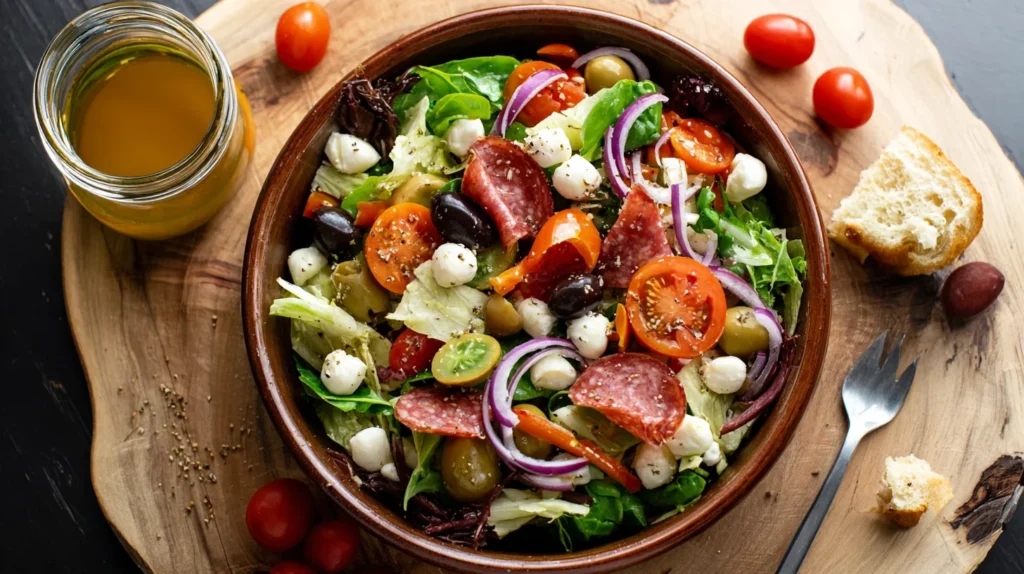
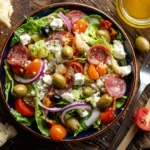
Easy Italian Antipasto Salad
- Prep Time: 15 minutes
- Cook Time: 0 minutes
- Total Time: 15 minutes
- Yield: 4 servings 1x
- Category: Salad
- Method: No-Cook
- Cuisine: Italian
Description
This antipasto salad is a bold, vibrant dish filled with Italian meats, cheeses, and marinated veggies, dressed in a tangy red wine vinaigrette. Perfect as a make-ahead lunch or a showstopping dinner starter.
Ingredients
1 head romaine lettuce, chopped
1/2 cup cherry tomatoes, halved
1/2 cup roasted red peppers, sliced
1/2 cup marinated artichoke hearts, chopped
1/4 cup black or kalamata olives
1/2 cup fresh mozzarella pearls
1/4 cup provolone, cubed
1/4 cup sliced pepperoni or salami
1/4 cup red onion, thinly sliced
Fresh basil or parsley, for garnish
Instructions
1. Chop all vegetables and drain any marinated items.
2. Layer the romaine in a large bowl or platter.
3. Top with meats, cheeses, veggies, and olives.
4. In a separate jar, shake together vinaigrette ingredients.
5. Drizzle salad lightly with dressing just before serving.
6. Garnish with fresh herbs and serve immediately.
Notes
Make ahead by storing components separately and dressing just before serving.
Pairs well with crusty bread or lemony beverages.
Nutrition
- Serving Size: 1 bowl
- Calories: 310
- Sugar: 4g
- Sodium: 720mg
- Fat: 24g
- Saturated Fat: 9g
- Unsaturated Fat: 14g
- Trans Fat: 0g
- Carbohydrates: 9g
- Fiber: 3g
- Protein: 14g
- Cholesterol: 45mg
Keywords: antipasto salad, Italian salad, lunch salad, no cook salad
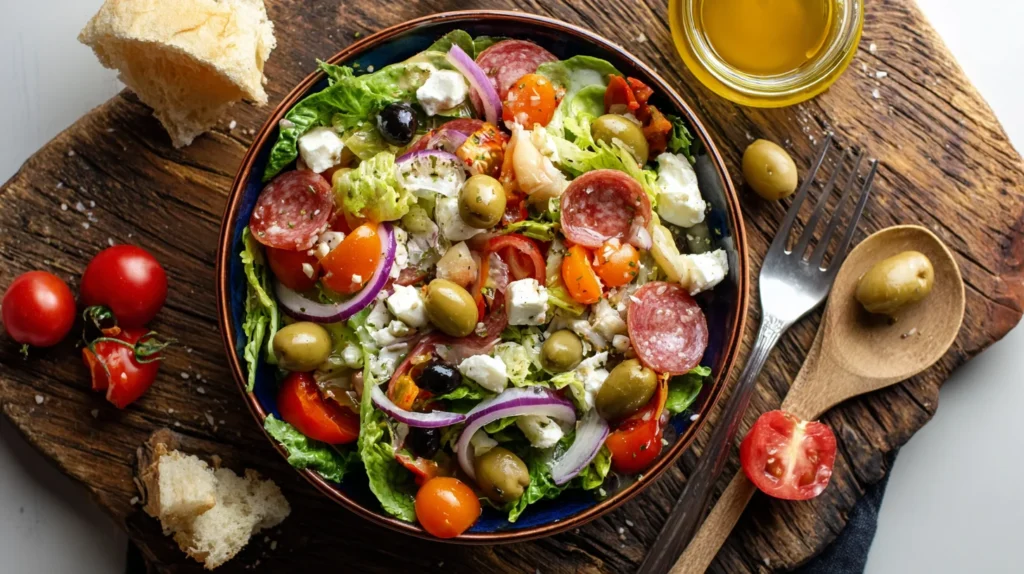
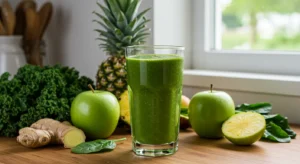


1 thought on “Easy Italian Antipasto Salad”